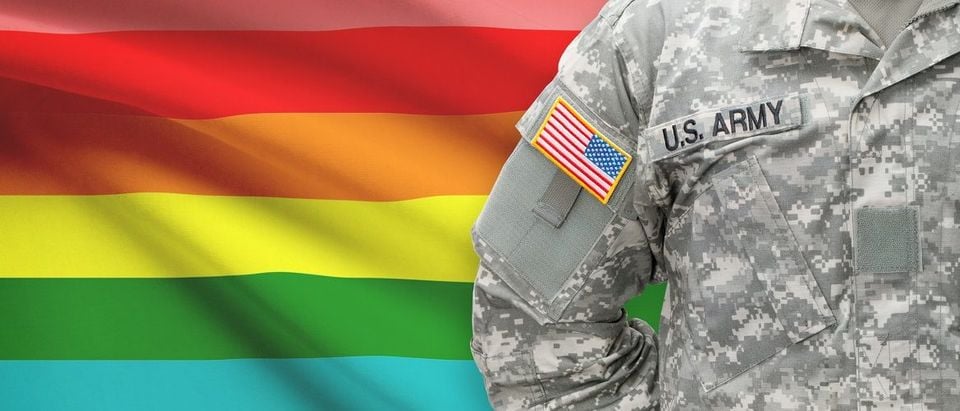President Trump’s July 26th LGBTQ directives signaled his intention to ban the politicized transgender production from the theater of war.
LGBTQ is a political program why? Central to the concept of “Lesbian, Gay, Bisexual, Transgender, Queer and Questioning” in the military is the idea of a group whose members have chosen to identify not as Private X or Private Z, but as a party to a political fraternity that promises and delivers an aggressive, noisy, sexual identity politics.
Evangelizing for the cause is implicit in the introduction of this political production into the military. Ditto payment for drastic elective medical procedures and the attendant hormonal maintenance.
In other words, LGBTQ in the military isn’t about enhancing a fighting force, it’s about introducing another state-driven reformation program. Egalitarian access here aims, inadvertently (as always), to grow an arm of government and, at the same time, “re-educate” the country.
Moreover, LGBTQ in the military is but another “Draconian social policy [enforced] without showing any interest in—and in many cases actively suppressing—good-faith information about how those policies [are] playing out at ground level,” in the prescient words of Stephanie Gutmann, author of “The Kinder, Gentler Military: Can America’s Gender-Neutral Fighting Force Still Win Wars?”
Girls: It was about their presence in the military that Gutmann was cautioning, circa 2000, not “Lesbian, Gay, Bisexual, Transgender, Queer and Questioning.”
As trailblazing as Ms. Gutmann’s shoe-leather investigation was, back then, into the way women had transformed the military, its morale and readiness—never could this author have imagined that from gender neutrality, the military would move into the even Braver New World of gender fluidity.
Gutmann saddled “Presidents George Bush and Bill Clinton, Secretaries of Defense Richard Cheney, Les Aspin, and William Cohen, the Congresses who wrote and passed the bills they signed, and the Pentagon leadership who just grinned nervously and sat on their hands while all of this was going on.”
What were the fatal conceits of these leaders and their legislation?
“One of the projects mesmerizing the brass throughout the nineties was the integration of women. … [T]he nineties were a decade in which the brass handed over their soldiers to social planners in love with an unworkable (and in many senses undesirable) vision of a politically correct utopia, one in which men and women toil side by side, equally good at the same tasks, interchangeable, and, of course, utterly undistracted by sexual interest.”
“[W]omen have been in the forces since … well … forever,” observed Gutmann. “But something new happened in the nineties in respect to the way the military handled ‘women’s issues.’ The goals “changed from making good use of the relatively small numbers of women the military had been attracting over the years, to achieving what President Clinton and Secretary of the Army Togo West [had] called ‘a force that looks like America.'”
The rest is history. The “New Army,” as it was openly termed, was created, “the warrior culture” obliterated, replaced with a weepy sensitivity. What appalled Ms. Gutmann was, again, the utter disinterest expressed by “the big boys (and a few big girls)” “in the hearts and minds of soldiers, sailors, Marines, and airmen in various ways during the last half of the nineties.”
This craven indifference is still apparent today, and is evinced in leadership’s reaction to President Trump’s transgender-policy impetus. When Sen. Orrin Hatch, joined by GOP leaders, enjoined the president against his transgender ban—did he/they show any interest in “good-faith information” about how transsexualism “plays out at ground level,” to echo Gutmann’s charge against political and military leadership, circa 2000?
Do these arch social-planners give a hoot about how flesh-and-blood men interact with a mate who suddenly grows breasts and bats eyelashes at a buddy? And how do these layered dynamics affect life-and-death situations?
Still, LGBTQ in the military is inconsequential by now. It’s a minor matter in a spent force, shot through with punitive sexual politics, hobbled and demoralized by the needs of women, as interpreted by military and political leadership.
To the surprise of liberals, a few good women have protested. Former Army Spec. Catherine Aspy, for instance. Her account, “published in Reader’s Digest, February, 1999,” was relayed by columnist Fred Reed. Aspy, who had “graduated from Harvard in 1992 and enlisted in the Army in 1995,” said this:
I was stunned. The Army was a vast day-care center, full of unmarried teen-age mothers using it as a welfare home. I took training seriously and really tried to keep up with the men. I found I couldn’t. It wasn’t even close. I had no idea the difference in physical ability was so huge. There were always crowds of women sitting out exercises or on crutches from training injuries. They [the Army] were so scared of sexual harassment that women weren’t allowed to go anywhere without another woman along. They called them ‘Battle Buddies.’ It was crazy. I was twenty-six years old but I couldn’t go to the bathroom by myself.
When all is said and done, LGBTQ is a fig leaf, camouflaging that the army was neutered by “recruiting nineties style,” where nothing less than “proportional representation” of women became the recruiting goal. The official line then became “something like, ‘We want you [ladies] to join us; we want you to stay with us. Tell us what you don’t feel ‘comfortable’ with so we can change it.”
And they did.
Ilana Mercer has been writing a paleolibertarian column since 1999, and is the author of The Trump Revolution: The Donald’s Creative Destruction Deconstructed (June, 2016) & Into the Cannibal’s Pot: Lessons for America From Post-Apartheid South Africa (2011). Follow her on Twitter, Facebook, Gab & YouTube.


